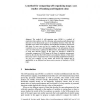Free Online Productivity Tools
i2Speak
i2Symbol
i2OCR
iTex2Img
iWeb2Print
iWeb2Shot
i2Type
iPdf2Split
iPdf2Merge
i2Bopomofo
i2Arabic
i2Style
i2Image
i2PDF
iLatex2Rtf
Sci2ools
ADBIS
2007
Springer
2007
Springer
A Method for Comparing Self-organizing Maps: Case Studies of Banking and Linguistic Data
The method of self-organizing maps (SOM) is a method of exploratory data analysis used for clustering and projecting multi-dimensional data into a lower-dimensional space to reveal hidden structure of the data. The algorithm used retains local similarity and neighborhood relations between the data items. In some cases we have to compare the structure of data items visualized on two or more self-organizing maps (i.e. the information about the same set of data items is gathered in different tasks, from different respondents or using time intervals (lags)). In this paper we introduce a method for systematic comparison of SOM maps in the form of similarity measurement. Based on the idea that the SOM retains local similarity relations of data items those maps can be compared in terms of corresponding neighborhood relations. We give two examples of case studies and discuss the method and its applicability as an additional and more precise measure of similarity of SOM maps.
Related Content
| Added | 06 Jun 2010 |
| Updated | 06 Jun 2010 |
| Type | Conference |
| Year | 2007 |
| Where | ADBIS |
| Authors | Toomas Kirt, Ene Vainik, Leo Vohandu |
Comments (0)

